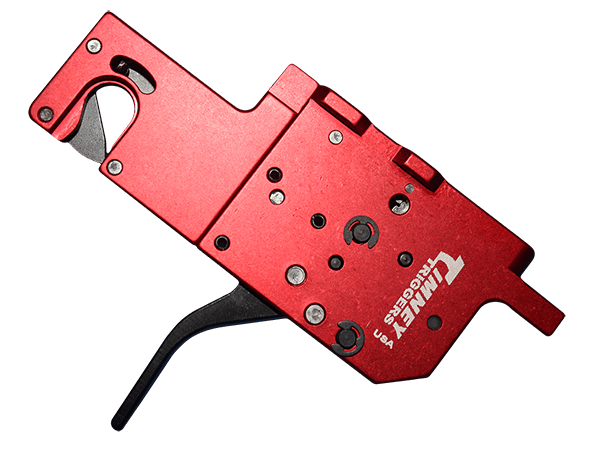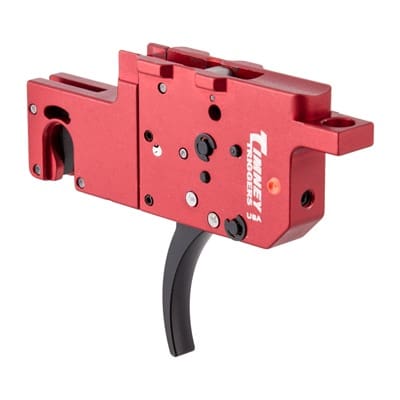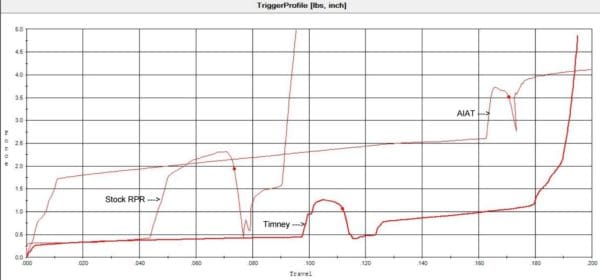
By Louis K. Bonham
Since its release in 2015, the Ruger Precision Rifle has been a smash hit. For a bit over $1000 (street price), you get a user-friendly, free floated, sub-MOA long distance rifle in 6.5 Creedmoor or .308 (and now 6mm Creedmoor, too). Indeed, the success of the RPR seems to have opened the floodgates in this market segment, with many other manufacturers now offering competing products at about the same price point, giving long range shooters access to gear that would have cost them several thousand bucks just a few years ago.
As Tyler Kee found in his review, a bone-stock RPR is a superb rifle that’s more accurate than most of us can shoot, with an excellent adjustable trigger Tyler described as “absolutely perfect.”
But can you improve on ‘perfection’? The folks at Timney Triggers thought so, and as we’ll see it’s pretty clear they were more than up to the task.

Available in both straight and curved trigger models, the Timney Two-State Trigger for the RPR is a drop-in replacement for the stock RPR trigger pack. Timney’s trigger lacks the blade safety of the stock trigger (which I disliked and disabled on my RPR). As with other Timney trigger packs, the trigger housing is CNC machined from a 6061 T6 alloy, and the sear is wire EDM cut and Teflon-nickel coated. It is user adjustable from 1 to 3.5 lbs, but unlike the stock trigger the pull weight cannot be adjusted without first disassembling the rifle.
The Timney comes in a simple blister package, with no documentation included (and none is available on the Timney website). Nevertheless, installation is ridiculously easy — just drop it in, tighten one screw, and reassemble the rifle (two more screws).
The trigger I received was set at the factory at a tad over two pounds, with a very crisp and clean break. I prefer a very light trigger on a precision rifle, and the description on the Timney website at that time indicated that it was adjustable down to 8 oz. The lowest I was able to get the trigger to go, though, was just under one pound. But at that point the sear wouldn’t reliably reset.
As it turns out, the description on the Timney website (since corrected) was a bit misleading – each stage of the trigger is adjustable down to half a pound, so the actual minimum is a total of about a pound. The Timney tech folks advised me that getting it down that low also required a bit of playing with all the adjustment screws (and how to do so doesn’t appear to be documented anywhere available to the consumer).
In any event, I shipped it back and at my request they set it as low as it would reliably and safely function and returned it to me. (If you order from the Timney website, you can specify what weight you want and they will set it for you.)
So how does it compare to the stock trigger? Let’s put it this way: I’ve had three other RPR owners try it out, and the universal response mirrors mine: “shut up and take my money.” It’s simply superb. There’s no grittiness at all, and no perceptible creep once you hit the second stage — just a glass-rod break. If you like a very light trigger, you can get it down to about half the stock trigger’s lowest setting.
The Dvorak TriggerScan graphs say it all (click to enlarge):
The amount of travel on the Timney from the end of the first stage to break is only 0.015. That’s half of what you see on the RPR’s stock trigger (which is a very respectable 0.030). By way of reference, the third graph is the trigger of an Accuracy International Accuracy Tactical, which measured a scant 0.008. (Jeremy S. says this AIAT has the best trigger he’s seen on the TriggerScan.)
Conclusion
While Ruger’s stock trigger is very, very good, the Timney replacement is hands-down a better product. In short, shut up and take my money.
Specifications: Timney Ruger Precision Two-Stage Trigger
Item number: #650
Shoe: Straight or curved
First stage pull weight: 8oz
Second sage pull weight: 8oz. to 3lbs.
Price: 219.95
Ratings (out of five stars):
Fundamentals: * * * * *
OK, so the trigger on a $4,500 Accuracy International has a few thousandths of an inch shorter travel. The Timney is still a top flight trigger.
Features: * * * *
It is user adjustable, but you have to do some experimenting to figure out how. Not terribly difficult, but it would help if Timney would post at least some documentation about how to do it.
Value: * * * *
No other expenditure of this amount will make such an appreciable improvement in your accuracy. All in all, a very fair price.
Overall: * * * * *
The more I shoot it, the more I like it. This gets my highest recommendation.
[Acknowledgement: Thanks to George A. and Keith from Spokane, Washington for their assistance with the TriggerScan testing, as well as to TTAG’s Jeremy S. for running it.]





Very nice. I hope they make one for the mini soon.
A two-stage trigger that isn’t adjustable below a pound? What was the point of the two-stage trigger?
I have my Anschuetz two-stage trigger adjusted to about six to eight ounces. Most benchrest rifles running two stage triggers are adjusted to that, or even less. The whole point of a two stage trigger is that the first stage is a bunch of safety interlocks to prevent the sear from slipping off the narrow engagement necessary to obtain pulls down in the single-digit ounce range. This way, you can have a trigger that is drop/shock safe, but still has a pull weight down under a pound.
Examples of two stage triggers that can be set very light would be the Karl Kenyon[*] trigger and the modern two-stage triggers used in benchrest/F-class, the “Bix’n Andy” triggers. Both can be set reliably down into single-digit ounce pulls. Another trigger from the heyday of target shooting was the Canjar trigger, out of Denver, CO.
Karl Kenyon was a gunsmith in Ely, Nevada, known almost exclusively for his work on triggers, and especially for his work on Winchester Model 52 rifle triggers. He passed away in 2011, and the gunsmithing community lost a very keen mind on the subject of what it takes to make a reliable, safe, and excellent trigger. Today, Pacific Gauge & Tool is producing a reproduction of the Kenyon trigger, adapted for the Rem700 action. From what I remember, it could be set down to six ounces. I’ve had the privilege of shooting 52’s with a Kenyon trigger on them – they’re exceedingly nice. All of Mr. Kenyon’s triggers were made by hand, with a hacksaw, files, polishing stones and torches for the heat treatment. He made them for 52’s, Remington 37’s, Rem700’s, BSA Martini’s, Model 70’s, and a few more that I can’t think of just now.
As I mentioned, I also like a very light two stage trigger . . . the blueprinted, hand-tuned one on my Benjamin Marauder is more like a telepathic link after you take up the first stage.
When I learned from the techs that the Timney couldn’t be adjusted down to single ounce weights, I was initially disappointed, but after shooting it a bunch I’m sold. For whatever reason, it feels lighter than it actually is, and like most Timneys it seems to be very solid. Give it a try.
Could it be finger placement? Maybe lower placement, better leverage lighter feel? They offer or at least did offer it in .243Win. While I have yet to see match grade .243 Win commercial ammo. With cheap 100gr Perfecta (Distributed by Tulammo, made in Italy, by Fiocchi I’m GUESSING) from Wally World. I’ve gotten just under 1 MOA @100yds out of my first gen RPR from bipod front, bag rear bench a number of times. That ammo doing so well is wrong on many levels, but speaks highly of the rifle.
Does it also fit the Ruger American Rifle? What about the American Rimfire? I know all 3 use very similar trigger groups, but are they actually interchangeable?
Dammit Guy! Now that you have asked that, specifically the RA Rimfire bit, I need to know too. Thanks for making me spend more money.
Not a bad price. If they can set one for me at 8-10 ounces, I’ll buy one.
I believe proper etiquette would have been giving credit to Greg Piet of Sin City Precision and TRGRiQ for the installation video used in this article. Just saying…
Comments are closed.